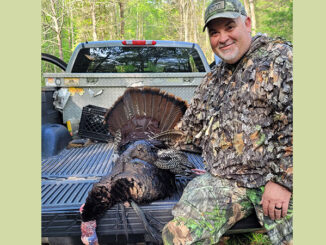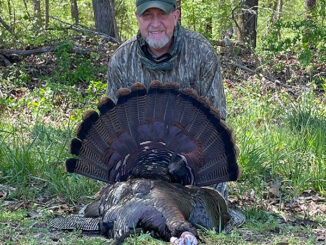
A stealthy approach and accurate cast can put you in contact with plenty of super-shallow redfish this month.
The boat was launched just as the tide began to rise. The full moon, a day away, promised a very high tide, and the destinations were flats where the redfish congregate during those unusual tides. The timing provided a chance to fish the flats with the water both rising into and falling out of the grass.
The targets were slot-sized reds, 15 to 23 inches, and the area was Winyah Bay out of Georgetown, one of the best places along South Carolina’s coast to bring home your three-fish limit for the grill. An estuary that covers 525,000 acres at the confluence of the Pee Dee, Waccamaw, Black and Sampit rivers, Winyah bay is a bucket-list destination for fishermen targeting reds, speckled trout, tarpon, black drum and flounder.
But it’s redfish that brings most anglers to Winyah Bay, and that plays into the hands of Capt. Steve Roff of Barrier Island Charters, who spends hundreds of days every year targeting the fish that are also known as puppy drum or spot-tail bass.
One of Roff’s favorite ways to fish is to move slowly onto shallow flats at the beginning of a rising tide that’s going to be extra-high and sight-fishing. He’ll either pole his boat along slowly or slide out and wade to make the soft presentations necessary. Either way, he’s looking for tailing fish — reds that are nosing down to feed, with their tails breaking the surface — and trying to put his bait or lure a foot or two in front of them.
“Stealth is critical when fishing these shallow flats. The water is so shallow, you must make a gentle presentation,” said Roff, who suggests a balance between live and artificial baits. “I really like to toss some fingerling mullet along the grass under a medium cork when targeting fish along the grass. The action of these 3- to 4-inch baits is irresistible.
“I don’t just stop there; I also like to throw some artificial baits while the mullet are working. You never know which is going to work at that moment.”
Roff said one of the biggest mistakes fishermen make when fishing live bait in and around is not leaving it in place long enough.
“You have to allow the scent to work and give the fish time to find the bait.” he said, often leaving a bait alone for four or five minutes so its scent fills the area gets reds searching for it. “When one bites, you have a good chance of getting four or five more in the same area.”
When it comes to artificial bait, Roff has plenty of guides and other anglers who agree with him that Gulp baits are hard to beat, but he’ll also use a 4-inch Vudu shrimp and Vudu mullet, with pearl/chartreuse a productive color in many situations.
“This technique is a lot like bass fishing; you cast along the structure and retrieve it back in,” he said. “Try and get as close to or even into the grass when using these artificial baits.”
Many of the grass edges are close to oyster bars, which can play havoc with tackle.
“My preference is light braid in the 10-pound range when targeting slot-fish,” said Roff, who will use a 24- to 30-inch leader of 20-pound fluorocarbon for artificials and a slightly shorter leader for live bait. “I will up the tackle to 30-pound braid when fishing near the oyster shells, but a fluorocarbon leader is important when the water is clear.
“When fishing the live mullet, you have to keep the bait off of the oyster bars, so be sure of your depth when you cast it out there.” said Roff, who waits his baits suspended under the cork at least a foot off the bottom.
Winyah Bay has numerous creeks, edges, drop-offs and places for redfish to hide. If you are fishing a normal tide and the big flats are inaccessible, look for islands and shell bars with sparse grass in clumps a couple of feet apart. Redfish love to meander through these areas looking for fiddler crabs and other morsels.
Robert McCarley of Reel Tight Fishing Charters is another Georgetown guide who focuses a lot of attention on Winyah bay. He is more of a live-bait angler and uses a variety of baits for redfish.
“I like finger mullet because they are so hardy” said McCarley, who will also fish with crabs when available. “Nothing beats a live crab when the reds are in tight to the grass. Reds patrol the grass looking for crabs, which are their favorite food, so when I can find some crabs for bait, that is definitely what I will use.”
McCarley spools his Penn spinning reels with 20-pound braid and ties a 3/0 circle hook at the end of a 20-inch leader of 20-pound fluorocarbon, a combination he says is deadly on reds looking for a good meal. He prefers the upper end of the bay to the lower, even moving into the brackish water of the Sampit and Black rivers to find reds that are in a stronger current.
Fish up in and along the outskirts of the rivers tend to have a lot of color than those caught in the bay proper. While they may not get as big, when targeting fish for the table, this can often be the best place to stretch a line.
DESTINATION INFORMATION
HOW TO GET THERE — Georgetown is accessed from north and south along the coast via US 17, and from inland via US 521, US 701 and SC 41/51. Three public boat ramps are popular: East Bay Street in downtown Georgetown, South Island Ferry at the end of County Road 18; Carroll Campbell Marine Complex off US 17 at the Sampit River.
WHEN TO GO — Redfish are active in and around WInyah Bay for much of the year, but May through November are prime months to target fish either in the bay proper or in the brackish to salty areas of the rivers that feed it. The level of salinity can determine how far up the Black, Waccamaw, Pee Dee and Sampit rivers reds might venture.
BEST TECHNIQUES — Fish live baits or artificials under popping corks along grass edges of on flats flooded on extremely high tides associated with the full moon. Use braided line on your spinning or baitcasting reels and a length of fluorocarbon for a leader. Gulp and Vudu baits are popular artificials.
FISHING INFO/GUIDES — Capt. Steve Roff, Barrier Island Guide Service, 843-446-7337, www.barrierislandguide.com; Capt. Robert McCarley, Reel Tight Fishing, 843-458-4157. See also Guides and Charters in Classifieds.
ACCOMMODATIONS — Hampton Inn-Georgetown Marina, 843-545-5000; Georgetown Chamber of Commerce, www.visitgeorge.com.
MAPS — Capt. Segull’s Nautical Charts, 888-473-4855, www.captainsegullcharts.com; Sealake Fishing; Guides, 800-411-0185, www.thegoodspots.com.








Be the first to comment